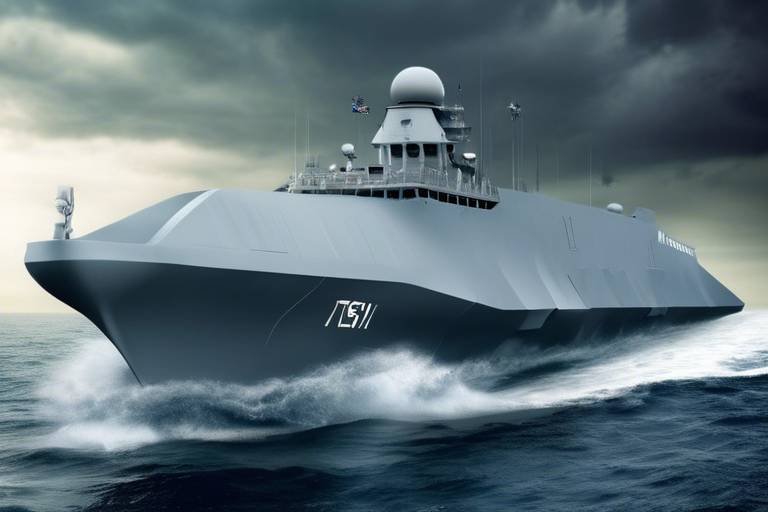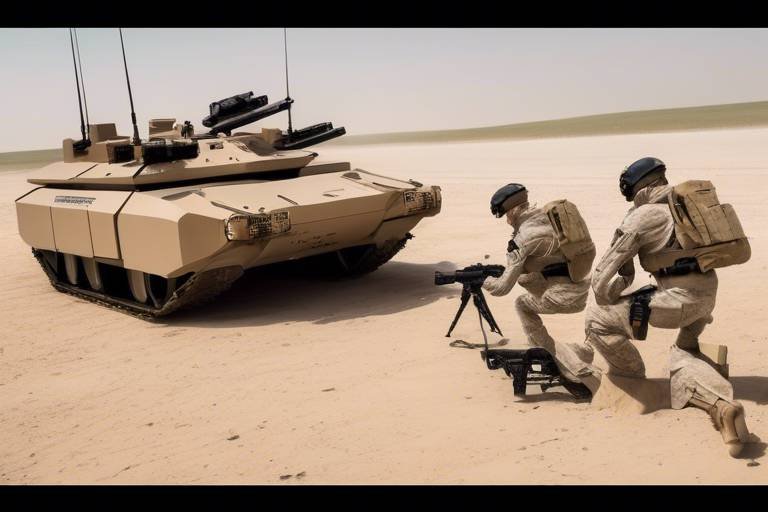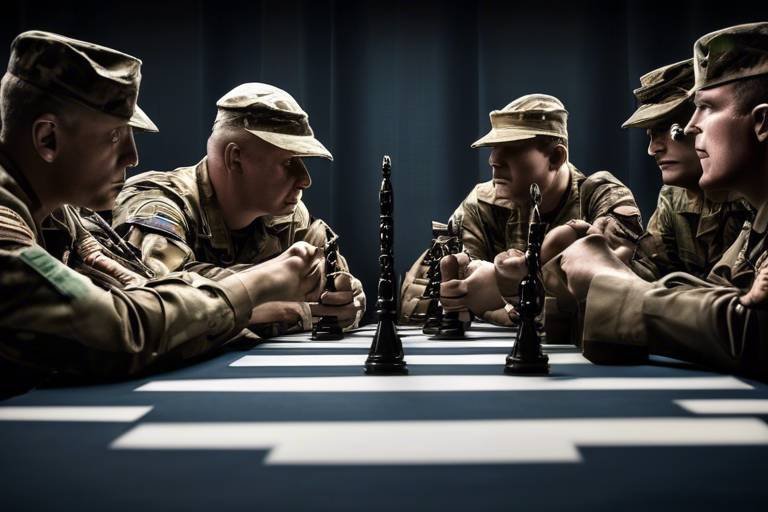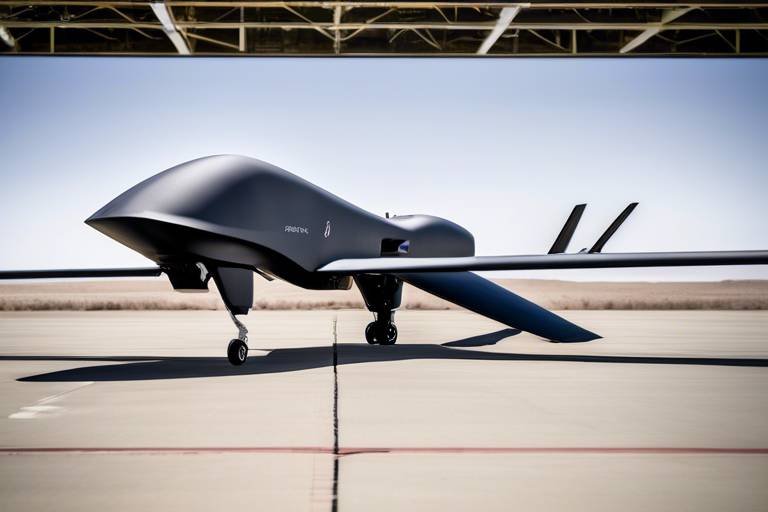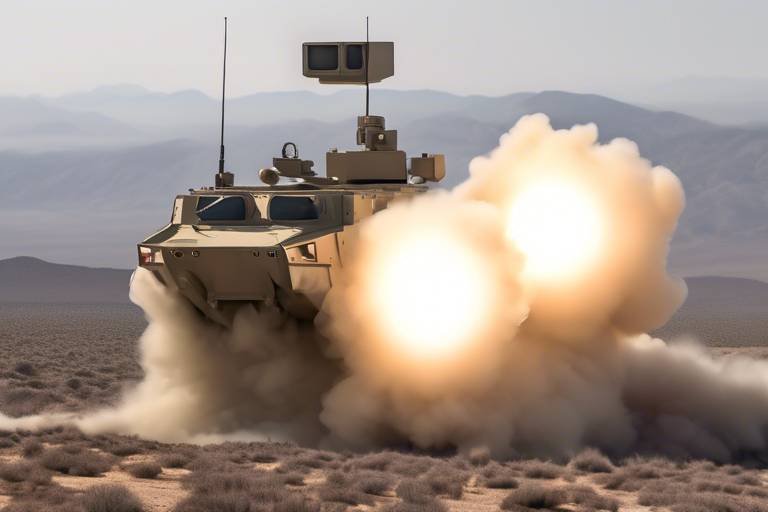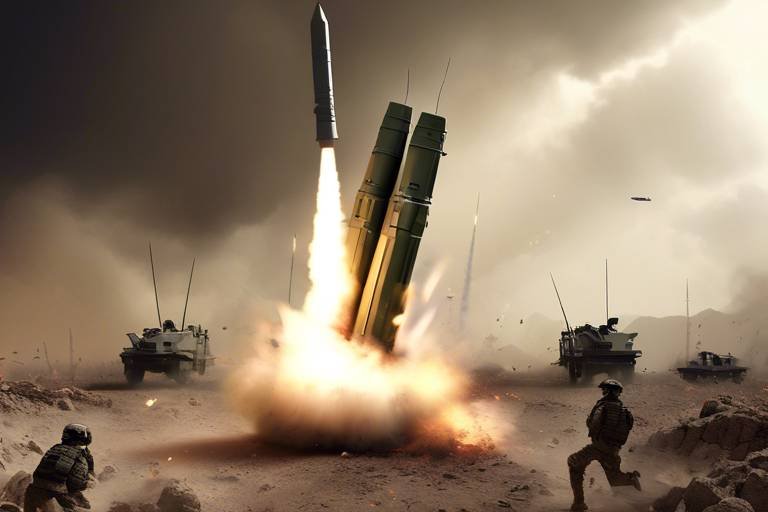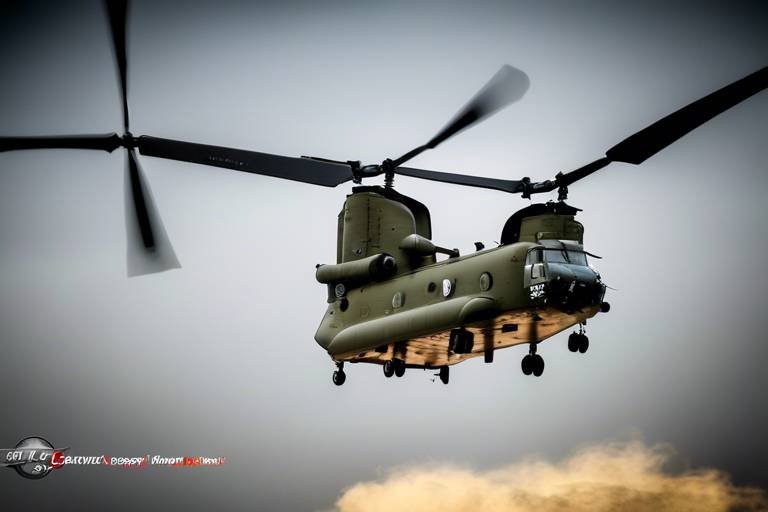Understanding the Challenges of Multi-Domain Operations
In today's rapidly evolving military landscape, the concept of multi-domain operations (MDO) has emerged as a critical strategy for achieving mission success. But what exactly does this entail? At its core, MDO involves the coordinated use of various military capabilities across multiple domains—land, air, sea, space, and cyber. This integrated approach is not just a buzzword; it's a necessity for modern warfare, where the lines between these domains are increasingly blurred. As we delve into the complexities of MDO, it becomes clear that understanding the associated challenges is essential for military leaders and strategists alike.
One of the most significant hurdles in implementing multi-domain operations is the inherent complexity of coordination. Each domain operates under its own set of rules, technologies, and operational procedures, which can create friction when trying to synchronize efforts. Imagine trying to assemble a jigsaw puzzle where each piece represents a different military branch—without a clear picture of what the final image should look like, it’s easy to see how pieces can get lost or misplaced. This lack of cohesion can lead to missed opportunities and reduced operational effectiveness.
Moreover, the challenges of MDO extend beyond mere coordination. They encompass a range of factors, including communication barriers, technological limitations, and even inter-service rivalries. Each of these elements plays a critical role in shaping the outcomes of military operations. For instance, if communication systems fail to provide real-time updates across domains, decision-making processes can be severely hampered. This can ultimately lead to a situation where forces are not operating on the same page, which is a recipe for disaster.
As we explore the intricacies of MDO, it’s also important to recognize that effective resource allocation is another major challenge. The distribution of resources across various domains can often be complicated, especially when each domain has its own unique operational needs. This complexity can lead to inefficiencies and may prevent forces from being adequately supported. As military operations become more intertwined, the need for a unified approach to resource management becomes increasingly apparent.
In summary, the challenges of multi-domain operations are multifaceted and require a comprehensive understanding to navigate effectively. As military strategies continue to evolve, addressing these challenges will be paramount for achieving success on the battlefield. The integration of various capabilities across domains is not just a theoretical concept; it’s an operational necessity that demands attention and action.
- What are multi-domain operations? Multi-domain operations refer to the coordinated use of land, air, sea, space, and cyber capabilities to achieve military objectives.
- Why is coordination important in multi-domain operations? Effective coordination ensures that different military branches can work together seamlessly, enhancing operational effectiveness and mission success.
- What are some common challenges faced in multi-domain operations? Common challenges include communication barriers, technological limitations, inter-service rivalries, and resource allocation issues.
- How can training improve multi-domain operations? Training programs that emphasize joint exercises and cross-domain proficiency can significantly enhance the readiness and interoperability of military forces.

The Concept of Multi-Domain Operations
Multi-domain operations (MDO) represent a revolutionary approach to modern military strategy, integrating various operational environments to achieve comprehensive mission success. Imagine a complex chess game where each piece not only has its own unique capabilities but also works in harmony with others to outmaneuver the opponent. This is precisely what MDO aims to accomplish across land, air, sea, space, and cyber domains. The ability to synchronize actions across these diverse realms is not just an advantage; it’s a necessity in today’s multifaceted battlefield.
At its core, MDO emphasizes the importance of coordinated efforts. In traditional military operations, forces might have operated primarily within their designated domains, leading to silos of information and capability. However, the modern threat landscape—characterized by rapid technological advancements and unpredictable adversaries—demands a more integrated approach. By leveraging capabilities across multiple domains, military forces can create a unified front that enhances situational awareness and operational effectiveness.
Consider the following key elements that define the essence of multi-domain operations:
- Integration: Seamless collaboration between different military branches is crucial for maximizing effectiveness.
- Flexibility: MDO allows forces to adapt quickly to changing circumstances, responding to threats as they arise.
- Information Dominance: Gaining and maintaining superiority in information sharing is vital for informed decision-making.
Moreover, the concept of MDO extends beyond mere coordination; it embodies a shift in how military forces perceive and engage with the operational environment. For instance, cyber capabilities can disrupt enemy communications while air assets provide real-time intelligence, creating a synergistic effect that enhances overall mission success. This interconnectedness highlights the need for a comprehensive understanding of how each domain interacts with others, leading to more effective strategies and outcomes.
As we delve deeper into the implications of MDO, it becomes clear that this approach is not only about military tactics but also about embracing a cultural shift within the armed forces. Training, resource allocation, and even leadership styles must evolve to support this integrated framework. The challenges are significant, but the potential rewards—greater operational success and enhanced national security—are even more compelling.
In summary, the concept of multi-domain operations is a multifaceted strategy that requires a deep understanding of how various military capabilities can work together to achieve common objectives. As the landscape of warfare continues to evolve, so too must our approaches to training, coordination, and execution in order to remain effective in the face of emerging threats.

Key Challenges in Coordination
When it comes to multi-domain operations, the ability to coordinate effectively across various military branches is not just important—it's absolutely essential. Imagine trying to conduct a symphony where each musician plays their own tune without listening to one another; that's what happens when coordination fails in military operations. The complexities involved in synchronizing efforts across land, air, sea, space, and cyber domains can create significant obstacles that impact operational effectiveness. Let's delve into some of the key challenges that arise in this intricate dance of military strategy.
One of the most significant hurdles in multi-domain operations is the presence of communication barriers. Picture a situation where a commander in the air is trying to relay crucial information to ground troops, but outdated communication systems create a lag. This delay can lead to disastrous consequences on the battlefield. Effective real-time information sharing is critical, yet these barriers can severely hinder decision-making processes. The inability to communicate swiftly and clearly not only affects the immediate operational outcomes but can also lead to a loss of trust among units, creating confusion and chaos when clarity is most needed.
Now, let’s talk about technological limitations. In an age where technology evolves at lightning speed, military forces sometimes find themselves using outdated systems that are not equipped to handle the complexities of modern warfare. Think of it like trying to run the latest software on an old computer; it just doesn’t work smoothly. These limitations can create bottlenecks in communication, making it difficult to integrate various capabilities across domains. Without the right technological infrastructure, the potential of multi-domain operations remains untapped, leaving forces vulnerable to adversaries who are more technologically savvy.
Another challenge that cannot be overlooked is the issue of inter-service rivalries. Each military branch has its own culture, priorities, and way of operating, which can lead to friction when it comes to collaboration. Imagine a sports team where each player insists on playing their own game instead of working towards a common goal; the result is a lack of cohesion and effectiveness. These rivalries can disrupt unified efforts, leading to inefficiencies and missed opportunities for operational success. It's crucial for military leaders to foster an environment that encourages collaboration and minimizes competition among branches.
Lastly, we must address the complexities surrounding resource allocation. Distributing resources effectively across multiple domains is no easy feat. It’s akin to trying to juggle multiple balls while riding a unicycle; one misstep can lead to chaos. Different operational needs require different resources, and the challenge lies in ensuring that each domain receives the support it needs without compromising the overall mission. Without a clear strategy for resource allocation, forces may find themselves underprepared in one domain while overextended in another, leading to vulnerabilities that adversaries can exploit.
In summary, the challenges of coordination in multi-domain operations are multifaceted and require a concerted effort to overcome. From communication barriers and technological limitations to inter-service rivalries and resource allocation issues, these obstacles can significantly impact operational effectiveness. Addressing these challenges is essential for achieving the integrated approach necessary for mission success.
- What are multi-domain operations? Multi-domain operations involve the coordinated use of land, air, sea, space, and cyber capabilities to achieve military objectives.
- Why is coordination important in military operations? Effective coordination ensures that all branches work together seamlessly, enhancing operational effectiveness and mission success.
- What are some common challenges in multi-domain operations? Common challenges include communication barriers, technological limitations, inter-service rivalries, and resource allocation issues.
- How can military forces improve coordination? Improving technology, fostering a collaborative culture, and developing effective resource allocation strategies can enhance coordination across domains.

Communication Barriers
In the intricate landscape of multi-domain operations, can act as formidable obstacles, impeding the seamless flow of information between various military branches. Imagine trying to conduct an orchestra where each musician is playing a different tune; that's akin to what happens when communication falters in the heat of battle. The effectiveness of multi-domain operations hinges on the ability to share real-time data across land, air, sea, space, and cyber domains. When communication lines are strained, the entire operation can suffer, leading to misinterpretations and delays that could have dire consequences.
One of the primary issues that arise from communication barriers is the disparity in communication systems used by different branches. Each military branch may have its own protocols and technology, which can create a jigsaw puzzle of information that is difficult to piece together. For instance, while the Army might rely on specific secure communication networks, the Air Force could be using entirely different systems, making it challenging to synchronize operations. This lack of interoperability not only affects decision-making processes but also creates an environment ripe for confusion and miscommunication.
Additionally, the timeliness of information sharing is crucial in high-stakes scenarios. When communication is delayed, it can result in missed opportunities or, worse, catastrophic mistakes. For example, if ground forces are unaware of air support being diverted due to communication lapses, they might find themselves in vulnerable positions. This highlights the need for a unified communication strategy that transcends individual service branches.
Moreover, the human element cannot be overlooked. The cultural differences between branches can also contribute to communication barriers. Each branch has its own set of values, terminologies, and operational philosophies. These differences can lead to misunderstandings and a lack of trust among units. Building a culture of collaboration and understanding is imperative for overcoming these barriers. Training programs that emphasize joint operations and communication can help bridge these gaps, fostering a more cohesive operational environment.
In conclusion, addressing communication barriers in multi-domain operations is not just about upgrading technology; it's about fostering a culture of collaboration and understanding among the various military branches. By enhancing interoperability and ensuring timely information sharing, we can significantly improve operational effectiveness and mission success. As we move forward, prioritizing communication will be key to navigating the complexities of modern warfare.
- What are multi-domain operations? Multi-domain operations involve the coordinated use of land, air, sea, space, and cyber capabilities to achieve military objectives.
- Why are communication barriers a concern in military operations? Communication barriers can lead to misunderstandings, delays, and ultimately impact the effectiveness of military operations.
- How can we overcome communication barriers? By implementing unified communication strategies, enhancing interoperability, and fostering a culture of collaboration among military branches.

Technological Limitations
When we talk about multi-domain operations, we often envision a seamless integration of various military capabilities across land, air, sea, space, and cyber realms. However, the reality is that can pose significant challenges to this vision. Imagine trying to coordinate a complex symphony where some instruments are out of tune or even missing; that’s what it feels like when technology fails to keep pace with operational demands.
One of the primary issues is the reliance on legacy systems. Many military branches still operate with outdated technologies that were designed for a different era of warfare. These systems often lack the interoperability needed for effective communication and coordination across domains. For instance, if the air force is using an older radar system that cannot communicate with the navy’s advanced tracking systems, vital information may be lost in translation. This disconnect can lead to delays in decision-making, which, in a military context, can be the difference between success and failure.
Moreover, the rapid pace of technological advancement means that what was cutting-edge yesterday can quickly become obsolete. This creates a constant need for upgrading systems and training personnel to use new technologies effectively. Unfortunately, budget constraints often hinder the ability to invest in the latest tools and systems, leaving many forces operating with inadequate resources. As a result, personnel may find themselves struggling to adapt to new technologies that they have not been adequately trained on, further complicating multi-domain operations.
Another critical aspect is cybersecurity. As military operations become increasingly reliant on digital systems, the threat of cyber attacks grows. A successful breach could compromise communication networks, leading to chaos in the command structure. Imagine a scenario where a cyber attack disrupts the ability to share real-time intelligence among ground troops, air support, and naval forces. The repercussions could be catastrophic, highlighting the need for robust cybersecurity measures in any multi-domain strategy.
To summarize, the technological limitations in multi-domain operations can be categorized into several key areas:
- Legacy Systems: Outdated technology that lacks interoperability.
- Rapid Technological Change: The need for constant upgrades and training.
- Cybersecurity Risks: Vulnerabilities that can disrupt operations.
Addressing these technological limitations is crucial for enhancing the effectiveness of multi-domain operations. It requires a concerted effort to invest in modern systems, provide adequate training, and develop robust cybersecurity protocols. Only then can military forces hope to achieve the level of integration necessary for success in today’s complex operational environment.
Q1: What are multi-domain operations?
Multi-domain operations refer to the coordinated use of land, air, sea, space, and cyber capabilities to achieve military objectives.
Q2: Why are technological limitations a concern in multi-domain operations?
Technological limitations can hinder communication, disrupt coordination, and compromise operational effectiveness, making it difficult to achieve mission success.
Q3: How can military forces overcome these technological challenges?
Investing in modern systems, providing continuous training, and enhancing cybersecurity measures are essential steps to overcome technological challenges in multi-domain operations.

Inter-Service Rivalries
Inter-service rivalries are a fascinating yet complex aspect of military operations. These rivalries often stem from the distinct cultures, traditions, and operational philosophies that each branch of the military embodies. Think of it like a family where each member has their own way of doing things; while they all share the same ultimate goal, their methods can sometimes clash. This competition can create significant friction, especially in multi-domain operations where seamless collaboration is crucial for success.
One of the most striking challenges posed by inter-service rivalries is the potential for miscommunication. When different branches prioritize their own objectives over collective goals, the result can be a fragmented approach to operations. Imagine trying to complete a jigsaw puzzle with pieces from different sets; the picture just won’t come together. This lack of cohesion can lead to delays in decision-making and a failure to respond effectively to evolving threats on the battlefield.
Moreover, these rivalries can manifest in resource allocation disputes. Each service branch may vie for a larger share of funding, personnel, and equipment, which can detract from the overall mission. For example, if the Army is focused on securing ground operations while the Air Force is pushing for aerial dominance, critical resources may be diverted away from where they are most needed. This tug-of-war can leave operational gaps that adversaries might exploit.
In addition to operational inefficiencies, inter-service rivalries can impact morale. When troops perceive that their branch is not being prioritized or is in competition with others, it can lead to disillusionment and a lack of unity. This is particularly concerning in multi-domain operations where trust and collaboration are essential. Building a culture of cooperation rather than competition is vital for enhancing operational effectiveness.
To mitigate the negative effects of inter-service rivalries, military leaders must foster an environment of collaboration and shared objectives. This can be achieved through joint training exercises and inter-service programs that emphasize the importance of working together. By creating opportunities for personnel from different branches to engage and learn from one another, the military can cultivate a more unified approach to multi-domain operations.
In summary, while inter-service rivalries are a natural part of military life, they pose significant challenges to the success of multi-domain operations. By addressing these rivalries head-on and promoting a culture of collaboration, the military can enhance its operational effectiveness and ensure that all branches are working toward a common goal.
- What are inter-service rivalries?
Inter-service rivalries refer to the competition and friction that can arise between different branches of the military, often affecting collaboration and operational effectiveness.
- How do inter-service rivalries impact multi-domain operations?
These rivalries can lead to miscommunication, resource allocation disputes, and decreased morale, all of which can hinder the success of multi-domain operations.
- What can be done to mitigate the effects of inter-service rivalries?
Fostering a culture of collaboration through joint training exercises and emphasizing shared objectives can help reduce the negative impacts of these rivalries.

Resource Allocation Issues
Resource allocation in multi-domain operations is a complex puzzle that military strategists must solve to ensure mission success. Imagine trying to fill a jigsaw puzzle where each piece represents a different domain—land, air, sea, space, and cyber. Each piece must fit perfectly with the others; otherwise, the picture remains incomplete. The challenge lies in distributing limited resources effectively across these diverse operational needs, which can often lead to friction and inefficiencies.
One of the primary issues is the competing demands from various military branches. Each branch has its own priorities and operational requirements, which can lead to conflicts over resource allocation. For instance, while the air force may require advanced aircraft for air superiority, the navy might be focused on enhancing its fleet capabilities. This tug-of-war can result in delays and compromises, ultimately affecting the overall mission effectiveness.
Moreover, the budget constraints faced by military organizations further complicate the allocation process. With limited funding, decision-makers must prioritize which domains receive resources, often leading to underfunded areas that could be critical in a multi-domain conflict. This situation can create a domino effect—when one domain is under-resourced, it can hinder the performance of others, leading to a cascading impact on operational readiness.
Additionally, geographical considerations play a significant role in resource allocation. Different regions may have unique requirements based on the nature of threats they face. For example, a region with active naval threats may necessitate a stronger maritime presence, while another area might require enhanced cyber capabilities to counteract digital warfare. Balancing these geographical demands while maintaining a cohesive operational strategy is no small feat.
To navigate these challenges, military leaders often turn to data-driven decision-making. By leveraging advanced analytics and real-time data, they can make informed choices about where to allocate resources. This approach not only helps in understanding current operational needs but also in forecasting future demands based on emerging threats and geopolitical trends.
In conclusion, the issues surrounding resource allocation in multi-domain operations are multifaceted and require a strategic approach. By recognizing the competing demands, budget constraints, and geographical considerations, military organizations can work towards more effective and integrated resource distribution. This, in turn, can lead to a more robust operational capability, ensuring that all domains work in harmony to achieve mission success.
- What are multi-domain operations? Multi-domain operations refer to the coordinated use of various military capabilities across land, air, sea, space, and cyber domains to achieve strategic objectives.
- Why is resource allocation important in multi-domain operations? Effective resource allocation ensures that all military branches can operate cohesively and efficiently, maximizing operational effectiveness and mission success.
- How can military organizations improve resource allocation? By utilizing data-driven decision-making and fostering inter-service collaboration, military organizations can enhance their resource allocation processes.
- What role does training play in multi-domain operations? Training is crucial for preparing personnel to operate effectively across different domains, emphasizing joint exercises and cross-domain proficiency.

Training for Multi-Domain Operations
Training personnel for multi-domain operations is not just a checkbox on a list; it's a fundamental requirement for achieving success in today’s complex battlefield. As military strategies evolve, so too must the methods we use to prepare our forces. The modern operational environment demands that troops are proficient not only in their specific domains—land, air, sea, space, and cyber—but also in how these domains interact with one another. This means that training must be comprehensive, integrating various capabilities and fostering a culture of collaboration.
One of the most effective ways to prepare for multi-domain operations is through joint exercises. These exercises are critical because they allow different military branches to work together in realistic scenarios that mimic the challenges they will face in actual combat. By engaging in joint exercises, personnel can improve their interoperability, which is essential for seamless coordination during multi-domain operations. For instance, a joint exercise might involve ground forces coordinating with air support to execute a mission, requiring both branches to communicate effectively and understand each other's capabilities and limitations.
Moreover, adapting training methods to reflect the realities of multi-domain operations is crucial. Traditional training methods often focus on single-domain proficiency, which can leave gaps in understanding how to operate effectively across multiple domains. Innovative training approaches that incorporate technology and simulations can bridge these gaps. For example, using virtual reality (VR) and augmented reality (AR) can create immersive training environments where personnel can practice multi-domain coordination without the risks associated with live exercises. This not only enhances learning but also allows for experimentation with strategies that might be too risky to test in actual operations.
To further illustrate the importance of training for multi-domain operations, consider the following table that outlines key components of effective training programs:
| Training Component | Description |
|---|---|
| Joint Exercises | Collaborative training sessions involving multiple military branches to improve interoperability. |
| Technology Integration | Utilizing advanced technologies like VR and AR to simulate multi-domain scenarios. |
| Cross-Domain Proficiency | Training personnel to understand and operate in various domains beyond their primary focus. |
| Realistic Scenarios | Creating training situations that closely mirror potential real-world challenges. |
Ultimately, the success of multi-domain operations hinges on how well we prepare our forces. As the military landscape continues to shift, ensuring that personnel are equipped with the necessary skills and knowledge to navigate complex, multi-domain environments will be crucial. By investing in comprehensive training programs that emphasize joint exercises and the integration of innovative technologies, we can enhance our operational effectiveness and ensure mission success.
- What are multi-domain operations? Multi-domain operations involve the coordinated use of land, air, sea, space, and cyber capabilities to achieve military objectives.
- Why are joint exercises important? They enhance interoperability and readiness among different military branches, preparing them for real-world multi-domain challenges.
- How can technology improve training? Technologies like VR and AR can create immersive training environments that simulate multi-domain operations effectively.

Joint Exercises
Joint exercises are the backbone of preparing military forces for the complexities of multi-domain operations. These exercises are not just a formality; they are essential for ensuring that different branches of the military can work together seamlessly. Imagine a symphony orchestra where each musician must play their part perfectly while remaining in sync with others. If one section falters, the entire performance can suffer. Similarly, in a military context, joint exercises allow different services—land, air, and sea—to practice their coordination, ensuring that they can respond effectively in real-world scenarios.
During these exercises, military personnel engage in realistic simulations that challenge their ability to operate across various domains. They practice everything from communication protocols to tactical maneuvers, which helps to identify potential weaknesses in joint operations. For instance, a joint exercise might simulate a scenario where ground troops need air support while simultaneously managing cyber threats. This complex environment tests the limits of their training and highlights the importance of adaptability and teamwork.
Moreover, joint exercises foster interoperability, which is critical in today's fast-paced combat situations. When forces from different branches work together, they learn not only about each other's capabilities but also about the nuances of joint decision-making processes. This experience is invaluable when it comes to real operations where time is of the essence. By participating in these exercises, military personnel develop a shared understanding of tactics and strategies, which can significantly enhance operational effectiveness.
However, the benefits of joint exercises extend beyond immediate tactical advantages. They also build trust and camaraderie among different military branches. Trust is a crucial element in any successful operation; if soldiers believe in their counterparts' capabilities, they are more likely to perform at their best. Joint exercises create opportunities for personnel to bond, share experiences, and develop a sense of unity that transcends individual service identities.
In conclusion, joint exercises are not merely drills; they are comprehensive training programs designed to prepare military forces for the challenges of multi-domain operations. By enhancing interoperability, fostering trust, and simulating real-world scenarios, these exercises play a pivotal role in ensuring mission success. As military strategies continue to evolve, the importance of joint exercises will only grow, making them an indispensable component of modern military training.
- What are joint exercises? Joint exercises are training activities that involve multiple branches of the military working together to improve coordination and operational effectiveness.
- Why are joint exercises important? They enhance interoperability, build trust among service members, and prepare forces for real-world multi-domain operations.
- How often do joint exercises occur? The frequency can vary based on military needs, but they are typically conducted regularly to ensure readiness.
- What types of scenarios are practiced in joint exercises? Scenarios can range from humanitarian missions to combat operations involving land, air, sea, and cyber domains.

Adapting Training Methods
In the fast-paced world of military operations, is not just beneficial; it's absolutely essential. As we stand on the brink of a new era in warfare, where the lines between land, air, sea, space, and cyber capabilities blur, traditional training approaches simply won't cut it anymore. Imagine trying to navigate a complex maze without a map; that's what our military personnel face if they're not adequately prepared for multi-domain operations. To meet these challenges head-on, we must embrace innovative training strategies that reflect the realities of modern combat.
One of the most effective ways to enhance readiness is through technology integration. Utilizing advanced simulations and virtual reality environments allows soldiers to experience realistic scenarios without the risks associated with live exercises. These immersive training tools can replicate a variety of situations across different domains, enabling personnel to practice their skills in a safe yet challenging environment. For instance, a soldier could practice coordinating an airstrike while simultaneously managing ground troop movements, all within a virtual landscape that mirrors potential real-world conditions.
Moreover, cross-domain proficiency is vital. Training programs should not only focus on a single domain but rather encourage personnel to understand and operate effectively across multiple areas. This can be achieved through joint exercises that bring together different branches of the military. For example, an exercise might involve the Army, Navy, and Air Force working together to achieve a common objective, fostering an environment where collaboration becomes second nature. Such experiences cultivate a sense of unity and shared purpose, which is crucial for mission success.
In addition to joint exercises, adapting training methods involves a continuous feedback loop. After each training session, it’s essential to analyze performance and outcomes. This could be done through debriefings where teams discuss what worked, what didn’t, and how they can improve. Such practices not only enhance learning but also instill a culture of constant improvement. Think of it like tuning a musical instrument; the more you refine and adjust, the better the overall performance becomes.
Furthermore, the incorporation of artificial intelligence (AI) into training programs can provide tailored learning experiences. AI can assess individual performance and suggest personalized training paths, ensuring that each service member receives the specific skills they need to thrive in multi-domain operations. This bespoke approach to training not only maximizes efficiency but also boosts confidence among personnel, knowing they are well-prepared for the challenges ahead.
In conclusion, adapting training methods for multi-domain operations requires a shift in mindset. It’s about embracing technology, fostering collaboration, and committing to continuous improvement. As we look to the future, the military must remain agile and innovative, ensuring that our forces are not just ready for today’s challenges but are also prepared for the uncertainties of tomorrow.
- What are multi-domain operations? Multi-domain operations involve the coordinated use of land, air, sea, space, and cyber capabilities to achieve military objectives.
- Why is adapting training methods important? Adapting training methods is crucial to prepare personnel for the complexities of modern warfare, ensuring they can operate effectively across multiple domains.
- How can technology enhance military training? Technology, such as simulations and virtual reality, can create realistic training environments that allow personnel to practice critical skills safely.
- What role do joint exercises play in military training? Joint exercises foster collaboration among different military branches, enhancing interoperability and ensuring a unified approach to mission objectives.
- How can artificial intelligence improve training programs? AI can analyze performance and provide personalized training recommendations, ensuring that each service member develops the skills they need.

Future of Multi-Domain Operations
The landscape of military strategy is constantly evolving, and the is poised to be shaped by a myriad of factors, including technological advancements, geopolitical shifts, and the ever-changing nature of warfare. As nations recognize the necessity of integrating capabilities across various domains—land, air, sea, space, and cyber—it's crucial to anticipate how these elements will interact in the coming years.
One of the most significant trends we can expect is the increased reliance on advanced technologies. Innovations such as artificial intelligence (AI), machine learning, and autonomous systems are already making waves in military operations. These technologies will not only enhance decision-making processes but also facilitate real-time data sharing across domains, thereby improving situational awareness. Imagine a battlefield where drones equipped with AI can analyze threats and communicate with ground forces instantaneously—this is the future we are heading toward.
Moreover, the geopolitical dynamics will play a pivotal role in shaping multi-domain operations. As nations vie for dominance in various regions, the need for a robust and adaptable military strategy will become more pronounced. Countries will likely invest in joint operations and alliances to counterbalance adversarial forces. This could lead to more collaborative training exercises among allied nations, fostering an environment where interoperability becomes second nature.
However, with these advancements come challenges. The complexity of coordination among various military branches will intensify. As operations become more integrated, ensuring seamless communication and collaboration will be paramount. This is where the development of comprehensive training programs will come into play. Military personnel must be equipped not only with domain-specific skills but also with the ability to operate effectively across multiple domains.
In addition, the cyber domain will continue to grow in importance. Cybersecurity threats are becoming increasingly sophisticated, and military strategies must evolve to counter these risks. Future multi-domain operations will likely incorporate robust cyber defense mechanisms, ensuring that critical systems remain secure and operational. This integration will require a new breed of military professionals who are well-versed in both traditional combat and cyber warfare.
As we look forward, it’s essential to consider how these factors will converge. The future of multi-domain operations will be characterized by:
- Enhanced Technological Integration: Leveraging cutting-edge technologies to improve operational efficiency.
- Increased Interoperability: Strengthening alliances and joint operations to counter global threats.
- Focus on Cybersecurity: Prioritizing the protection of information systems against cyber threats.
Ultimately, the success of future multi-domain operations will depend on the ability of military forces to adapt to these changes. As the battlefield evolves, so too must the strategies and training that underpin military readiness. The integration of diverse capabilities across all domains will not only enhance operational effectiveness but also ensure that nations remain prepared for the complexities of modern warfare.
Q1: What are multi-domain operations?
Multi-domain operations refer to the coordinated use of various military capabilities across land, air, sea, space, and cyber domains to achieve strategic objectives.
Q2: Why is training important for multi-domain operations?
Training is crucial because it prepares military personnel to operate seamlessly across different domains, enhancing interoperability and mission success.
Q3: How will technology influence future multi-domain operations?
Technology will play a significant role by improving communication, situational awareness, and operational efficiency through the use of AI, autonomous systems, and advanced cyber capabilities.
Frequently Asked Questions
- What are multi-domain operations?
Multi-domain operations involve the synchronized use of various military capabilities across land, air, sea, space, and cyber domains. This integrated approach is essential for achieving strategic military objectives in today’s complex battlefield.
- Why is coordination among military branches important?
Effective coordination is crucial because it enhances operational effectiveness. When different military branches work together seamlessly, they can leverage their unique strengths, leading to improved mission outcomes and increased efficiency.
- What are some common communication barriers in multi-domain operations?
Communication barriers can include differences in communication protocols, technological incompatibilities, and challenges in real-time information sharing. These issues can significantly hinder decision-making processes and operational success.
- How do technological limitations affect multi-domain operations?
Outdated or incompatible technology can restrict effective communication and coordination across different military branches. This can lead to delays in response times and reduced operational capabilities, ultimately impacting mission success.
- What role do inter-service rivalries play in multi-domain operations?
Inter-service rivalries can create friction and competition among military branches, which may disrupt collaborative efforts. This competition can hinder the ability to work together effectively, impacting overall mission success.
- How are resources allocated in multi-domain operations?
Resource allocation in multi-domain operations involves distributing personnel, equipment, and funding among various military branches. This process can be complex due to the diverse needs and priorities of each domain, requiring careful planning and coordination.
- Why is training essential for multi-domain operations?
Training is vital because it prepares personnel to operate effectively across different domains. Developing training programs that emphasize joint exercises and cross-domain proficiency ensures that military forces are ready to respond to modern threats.
- What are joint exercises, and why are they important?
Joint exercises are collaborative training activities that involve multiple military branches working together. These exercises enhance interoperability, improve communication, and ensure that forces are prepared for real-world multi-domain operations.
- How can training methods be adapted for multi-domain operations?
Training methods can be adapted by incorporating innovative approaches such as technology-driven simulations, virtual reality, and scenario-based training. This helps personnel gain practical experience in a controlled environment that reflects the realities of multi-domain operations.
- What is the future of multi-domain operations?
The future of multi-domain operations will likely be influenced by advancements in technology and shifting geopolitical dynamics. As new threats emerge and technology evolves, military strategies will need to adapt to maintain effectiveness in multi-domain environments.


